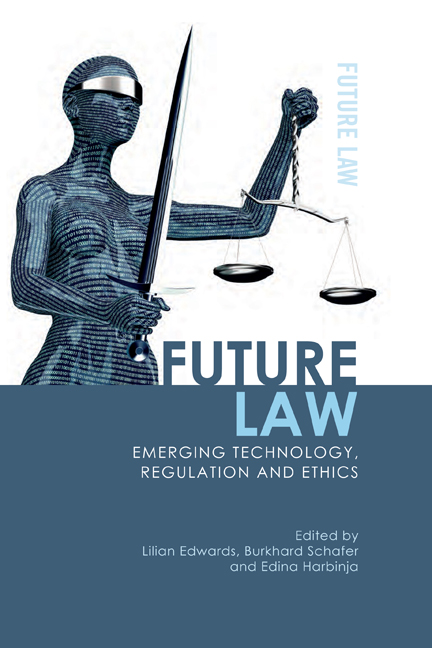Book contents
- Frontmatter
- Contents
- List of Contributors
- List of Figures and Tables
- Table of Cases
- Table of Legislation
- 1 The Future’s Already Here: It’s Just Unevenly Edited
- Part I From Privacy and Princesses, to Security and Star Wars
- 2 Privacy and Identity through the Eyes of Disney Princesses
- 3 White Noise from the White Goods? Privacy by Design for Ambient Domestic Computing
- 4 Citizen-consumers in a Personalised Galaxy: Emotion-influenced Decision Making, a True Path to the Dark Side?
- 5 Big Data Ethics: Darth Vader and the Green Cross Man
- 6 Security Vulnerabilities, Backdoors, Exploits and the Marketplace for Each: The Return of Boba Fett – Bug Bounty Hunter in the New Republic
- Part II A Matter of (Future) Life and Death
- 7 Will My Genes Really Help Me Fit Into Those Jeans? Personal Genomics and Wrap Contracts
- 8 On Living and Undead Wills: ZombAIs, Technology and the Future of Inheritance Law
- 9 ‘Be Right Back’: What Rights Do We Have over Post-mortem Avatars of Ourselves?
- Part III Regulating Autonomous Technologies: Software Are Doing it for Themselves
- 10 Autonomous Intelligent Agents and the Roman Law of Slavery
- 11 Autonomous Vehicles: An Analysis of the Regulatory and Legal Landscape
- Part IV Textual Poaching: Copyright in a Remixed World
- 12 Living in a Remixed World: Comparative Analysis of Transformative Uses in Copyright Law
- 13 Repost This: Instagram and the Art of Re-photography
- Index
3 - White Noise from the White Goods? Privacy by Design for Ambient Domestic Computing
Published online by Cambridge University Press: 17 September 2020
- Frontmatter
- Contents
- List of Contributors
- List of Figures and Tables
- Table of Cases
- Table of Legislation
- 1 The Future’s Already Here: It’s Just Unevenly Edited
- Part I From Privacy and Princesses, to Security and Star Wars
- 2 Privacy and Identity through the Eyes of Disney Princesses
- 3 White Noise from the White Goods? Privacy by Design for Ambient Domestic Computing
- 4 Citizen-consumers in a Personalised Galaxy: Emotion-influenced Decision Making, a True Path to the Dark Side?
- 5 Big Data Ethics: Darth Vader and the Green Cross Man
- 6 Security Vulnerabilities, Backdoors, Exploits and the Marketplace for Each: The Return of Boba Fett – Bug Bounty Hunter in the New Republic
- Part II A Matter of (Future) Life and Death
- 7 Will My Genes Really Help Me Fit Into Those Jeans? Personal Genomics and Wrap Contracts
- 8 On Living and Undead Wills: ZombAIs, Technology and the Future of Inheritance Law
- 9 ‘Be Right Back’: What Rights Do We Have over Post-mortem Avatars of Ourselves?
- Part III Regulating Autonomous Technologies: Software Are Doing it for Themselves
- 10 Autonomous Intelligent Agents and the Roman Law of Slavery
- 11 Autonomous Vehicles: An Analysis of the Regulatory and Legal Landscape
- Part IV Textual Poaching: Copyright in a Remixed World
- 12 Living in a Remixed World: Comparative Analysis of Transformative Uses in Copyright Law
- 13 Repost This: Instagram and the Art of Re-photography
- Index
Summary
The house was full of dead bodies, it seemed. It felt like a mechanical cemetery. So silent. None of the humming hidden energy of machines waiting to function at the tap of a button.
(Ray Bradbury, ‘The Veldt’, 1950)The house was an altar with ten thousand attendants, big, small, servicing, attending, in choirs. But the gods had gone away, and the ritual of the religion continued senselessly, uselessly.
(Ray Bradbury, ‘There Will Come Soft Rains’, 1950)Introduction
Ambient domestic computing systems have moved from science fiction to the lab to everyday life. They have become mundane, unremarkable artefacts in the home and in this chapter, we examine why this shift matters for privacy regulation, both conceptually and empirically. The Bradbury quotes above set the scene for this Gikii contribution, in which we’ll examine how smart homes have been envisioned in science fiction literature and film, both positively and negatively. We consider vintage visions of post-desktop computing, starting with Weiser's classic ubicomp and moving through the years, towards the current term du jour: the Internet of Things (IoT). The IoT can easily be dismissed as yet more tech industry marketing hype, like so many examples before, such as blockchain, big data analytics, cloud computing and Web 2.0, for example. However, in this chapter we dig deeper by unpacking how the IoT is framed both in technical and regulatory literature, in conjunction with how experts from technology law and design understand it in practice. Key to this is considering what harms could befall the humans left in the feedback loop living with smart domestic environments. Drawing on the regulatory solution of ‘privacy by design’ (PbD), we assess how computing professionals have been drawn into the regulatory fray. Instead of just functionally enabling the IoT through ubiquitous networking, ambient interfaces and cloud storage, they now also have a raft of wider human values to assimilate in design. Responsible research and innovation agendas seek to create a future of more trustworthy, secure and accountable domestic IoT. However, the practical role of the computing community in both regulating and creating smart homes that people actually want to live in is far from clear, but resolving it is a pressing concern.
- Type
- Chapter
- Information
- Future LawEmerging Technology, Regulation and Ethics, pp. 41 - 78Publisher: Edinburgh University PressPrint publication year: 2020

